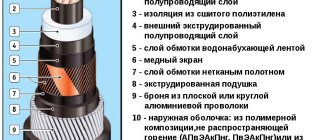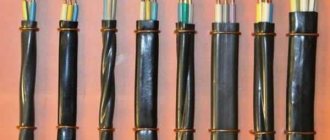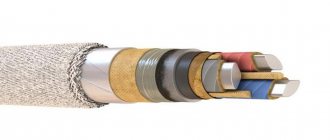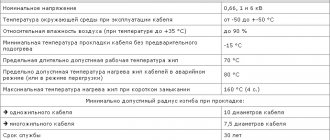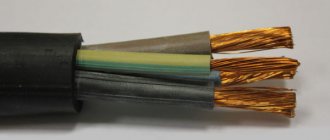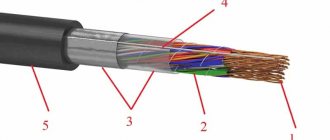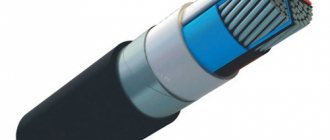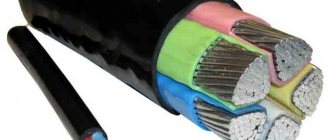To connect electrical equipment to a power supply network up to 1000 volts, as well as to install internal networks in domestic and industrial premises, various modifications of the VVG cable are most often used (for example, version VVGng). This demand is explained by its operational and technical characteristics. We invite you to familiarize yourself in detail with this type of cable products, find out the possible design options, their features and main technical parameters. Let's start with the design features.
Typical design
A cable of this type consists of copper or aluminum current-carrying conductors in the amount of 1-5 pieces (see B in Fig. 1). Depending on the design, they can be monolithic or multi-core.
VVG cable design
Each of the cores is covered with an insulating sheath (C) based on polyvinyl chloride (hereinafter referred to as PVC). A special dye has been added to its composition, which allows you to identify the wires in accordance with the color marking. The current-carrying parts of the cable are placed in a common PVC sheath (A).
This design is typical for all varieties, with the exception of the VVGP version and its modifications, which have a flat rather than round shape.
Cable VVG-P
Storage conditions
When constructing large projects, there is a need to purchase large volumes of building materials. This fully applies to cable and wire products. This amount of cable must be properly placed and storage conditions provided. For this purpose, special cable platforms or powerful racks are installed, ensuring the placement of cable drums in several tiers.
First of all, it is necessary to determine the place, terms and conditions of storage of cable products. These parameters are closely related to each other. For example, the maximum shelf life of cables in open areas is 2 years. Storage under sheds reaches 5 years, and in warehouses - 10 years.
The VVG cable is supplied wound on wooden or metal drums. It is imperative to ensure that the rows are wound evenly and tightly. The distance to the edge of the drum from the top row of turns is 100 mm for multi-core cables, 50 mm for single-core cables.
The lower end must be brought out through the hole and secured with sheet metal. The upper end is fixed to the inner cheek of the drum. Heat-shrinkable caps are installed on each end - moisture-proof caps. If there is a metal sheath, the ends of the cable are simply sealed or wrapped with PVC electrical tape. Storage temperature must be within the limits specified by the manufacturer. Otherwise, the plastic or rubber insulation will become brittle and lose its quality.
Decoding VVG markings and common modifications
The marking allows you to determine the characteristics and properties of cable products; it is deciphered as follows:
- Indicates the material from which the current-carrying elements are made. For aluminum, the symbol “A” is accepted; if the conductors are made of copper, then there is no designation.
- The purpose of the cable is that it can be control (marked “K”) or power (marked “K”). The former are used in control circuits of electrical equipment, the latter for powering it, respectively, control cables are designed for a lower current load, in fact, this and the large number of cores distinguishes KVVG from VVG.
Electric cable KVVG produced by the Concord plant (Smolensk) - The insulation material for current-carrying elements, in our case it is the symbol “B”, which indicates the use of PVC materials.
- A symbol indicating what the outer (general) insulating covering is made of. The letter "B" indicates that PVC is used.
- The presence or absence of protection, in the first case “B” is indicated, this means that the cable is armored, in the second case “G”.
In the basic version, the number of current-carrying elements and their cross-section are further indicated (highlighted in red in Fig. 4); if there is a grounding conductor of a smaller cross-section, it is indicated separately, for example: “3x10.0 + 1x6.0”.
Labeling example
Next, the rated voltage is indicated (circled in green in the figure - 0.66 kV), followed by GOST and/or TU (marked in yellow).
Do-it-yourself electrician: Choosing a power cable for internal installation
Good afternoon
This article will be devoted to a question that often arises among visitors to the Electrical section - which power cable to choose for electrical installation in an apartment or country house. This article will be useful both to those who plan to make their own electrics, and to those who have hiring teams - unfortunately, they often do not know which cable to use. In the article, a power cable is understood as a cable intended for the distribution and transmission of electricity at a voltage of 230 volts.
Due to the ban on indoor installation in newly constructed residential buildings, cables with aluminum conductors are not considered. Wires and cables for installation outside the building (including self-supporting insulated wires) are also not considered.
Main types of power cable for “home” electrical installation
In accordance with the PUE (Electrical Installation Rules):
2.1.48 Wires and cables should be used only in those areas specified in the standards and technical specifications for cables (wires).
Thus, for electrical installations in a building, you should use only those cables and wires that are specified in the technical specifications as “distribution and transmission of electrical energy.” Moreover, you should not look at the advertising slogans of sellers or even the inscription on the packaging, but at the manufacturer’s certificate for this brand of cable (can be found on the Internet).
VVG cable family (VVGng, VVGng-ls, VVGng-frls)
Cables of this group are most common for indoor installation in Russia and the CIS.
Copper cores of flexibility class 1 according to GOST 22483-2012 (rigid solid cores, hereinafter referred to as monocores) are covered with fire-retardant polyvinyl chloride (PVC) insulation. Non-flame propagating means that the cable in the flame source will light up, but if it is removed from the fire, it will immediately go out. Thus, fire cannot spread along the cable from the source of fire (for example, if the cable is damaged or short circuited). The cable itself has an outer sheath also made of polyvinyl chloride plastic (VVG means “vinyl - vinyl - bare”, that is, an unarmored cable with PVC core insulation and external PVC insulation). According to GOST 31996-2012, for sections used in everyday life, the cable may or may not have internal filling (something similar to the filling in the NYM cable) between the cores and the external insulation.
The VVG series cable is designed for transmission and distribution of electricity in stationary installations. Rated alternating voltage: up to 660 V or up to 1000 V. For home electrical installation, a 660 V (0.66 kV) cable is more than sufficient. The guaranteed service life of the cable is 30 years.
This cable looks like this (there is a round one - just VVG and a flat version, VVG-p, in the photo there is a round VVGng-ls from the St. Petersburg Sevkabel plant):
Overall, these cables are the right choice for home electrical installations. However, with some caveats:
- VVG - Has PVC insulation without special additives, therefore it does not propagate fire when laid alone. Group laying of several cables in a bundle is not allowed (but it is possible in a bundle when each cable is in its own corrugation).
- VVGng (“flame retardant”) - It has special additives in the insulation composition, which makes it possible to lay bundles of these cables together, while maintaining the fire retardant condition. This cable is most common in home electrical installations among those who do not know the current regulations on laying cables in residential premises.
- VVGng-ls (“low smoke” - low smoke) - In addition to all the advantages of the previous cables, it also has reduced smoke and gas emissions during combustion. This is important because when polyvinyl chloride plastic compounds burn, toxic substances that are dangerous to humans are released. To check, you can set fire to VVGng and VVGng-ls and compare - the first emits acrid, foul smoke in large quantities, which immediately starts to make your throat sore. If a bunch of such cables burns, you can actually choke on smoke. There is little smoke from VVGng-ls and it is not particularly poisonous. It is for this reason that this cable should be laid in residential premises (I will write in more detail later).
- VVGng-frls (“fire resistant, low smoke” - fire-resistant and low-smoke) - Has long-term resistance to combustion, that is, it retains its functions even in open fire conditions due to special insulation (mica-containing tapes). Designed for facilities with serious fire safety requirements (used, for example, to power fire alarm and smoke removal systems), using it at home is overkill, and it’s quite costly (even using high-quality VVGng-ls is quite expensive. But there are customers who who prefer such cables according to the principle “the best goes home.”
The fact that it is VVGng-ls, and not VVGng, that is intended for installation in residential buildings is stated in Table 2 of GOST 31565-2012 “Cable products. Fire safety requirements":
Thus, flame retardant and low smoke cables should be used for buildings (including residential premises).
If anything, Latin letters in brackets (A), (B) and so on mean the fire resistance category according to GOST R IEC 60332 (a series of standards), including GOST R IEC 60332-3-22-2005 “Testing of electrical and optical cables in conditions of exposure to flame." In this article I will not dwell on this in detail; category A is common in home wiring - any decent manufacturer has this category indicated in the cable brand, for example, VVG(A)ng-ls.
Can you use VVGng for home wiring? Well, if you don’t have to hand over wiring to firefighters (and home wiring is not handed over, unfortunately, a private owner can do whatever he wants), then who’s going to stop you?
At least, I think that it is better to lay VVGng than PVS (more on this later). In some Russian cities, especially small ones, it is very difficult or even impossible to buy VVGng-ls, so there it makes sense to use VVGng for lack of a better option.
And lastly, which option should you choose: round or flat? If you have a choice, then in general a round cable is better since it is much more resistant to bending and twisting, round VVG is less likely to be counterfeited (most Chinese and basement counterfeits are flat VVGp), its cores are better protected.
Prosky cable is ideal for laying in ceiling plaster due to its small thickness (let me remind you that ceilings cannot be stripped). It is easier to cut it with a construction knife (the article is about “do-it-yourself electrical installation”, so professional strippers, i.e. tools for stripping insulation, are not discussed in the article), but due to their tendency to twist, they will cause you a lot of trouble.
The main disadvantage of a round VVG compared to a flat one is that it is difficult to strip it without a professional stripper, for example, this one:
The next cable we will discuss, NYM, does not have this drawback. but at the same time it has other disadvantages that VVG lacks.
Some cable factories, for example, Kolchugino, for sections from 6 mm2 use internal filling of the cable with a special material that facilitates cutting (the so-called VVGz, which goes under the brand name of the usual VVG).
If you really need a flexible cable in a fixed wiring (which, by the way, is allowed by regulations, for example, clause 3 of GOST 22483-2012):
Cores of classes 1 and 2 are intended for cable products for stationary installation. Conductors of classes 3, 4, 5 and 6 are intended for flexible cable products, but they can also be used for cable products of fixed installation.
Then use the cable KGVVng-LS (or at least just KGVV ), designed for the transmission and distribution of electricity from power circuits (0.6 and 1 kV) and monitoring and control circuits on machines and mechanisms at voltages up to 660 V AC.
While I don't think control cables are the best choice for fixed wiring, that's what this cable is designed for.
There is also this option - VVGng-ls is laid up to the socket boxes, and in the socket boxes themselves the wiring is carried out with a flexible PuGV wire (formerly PV3). This is covered in another article.
NYM cable
This cable comes from Europe and, like potatoes imported from overseas, has taken root on Russian soil. It looks like this (produced by the European Helukabel plant):
The cable has core insulation made of flame retardant polyvinyl chloride.
The outer shell is also made of polyvinyl chloride. The cable cores are placed in a layer of chalk-filled rubber. This material serves to facilitate cable cutting - rubber, due to the presence of chalk in it, is easily torn by hand. The cable has a service life of 40 years, and the NYM outer sheath is much more sensitive to ultraviolet radiation compared to the VVG sheath, so this cable should not be laid openly where it will be constantly exposed to sunlight. I believe that this cable has caught on and become widespread due to two factors:
- Russian cable factories that adapted one of the VDE 0250 standards, according to which this cable was manufactured abroad on domestic rails (that is, specifications) and began producing “abibases” - cheap analogues of NYM under the brands NUM, NUM according to specifications. Rare cable factories (for example, Sevkabel) until recently produced NYM according to VDE, but now, as far as I know, they have stopped). Please note that in most stores you will not find NYM, but its adapted “clone” under the NUM brand. From now on I will call this entire family “NYM”.
- “Part-time electricians” (generalists, plasterers, etc.) who appreciated the significant ease of cutting NYM without special tools compared to VVG. Also, in my opinion, NYM looks more aesthetically pleasing than VVG and it is “softer”.
Some sellers (especially in the markets) position NYM and its “clones” (NUM) as triple-insulated cable, but this is not true - chalk-filled rubber is not insulated.
Also, the rubber in the cable has a significant disadvantage - it burns well. Therefore, laying NYM in bundles is not allowed (but in bundles, when each cable is packed in its own corrugation, it is possible). In addition to combustion, Russian-made cables have another problem with rubber, which I will discuss later. With the adoption of GOST 31565-2012 “Cable products. Fire safety requirements,” which was discussed in the article in the section about VVG, the NYM cable was actually banned for laying in rooms where people could be constantly present. True, this is relevant in any institutions where the project and work were accepted for compliance with fire safety (for example, all shopping and entertainment centers) since chalk-filled rubber greatly worsens the fire resistance class of a given cable, and in addition, the cable is not low-smoke (that is, relatively safe from the point of view of the emission of toxic smoke). But private owners continue to lay this cable in apartments - the standards are “not a decree” for many of them.
In order to avoid a drop in NYM sales as a result of this ban, the Sevkabel plant launched the production of a hybrid of a hedgehog (VDE) with a grass snake (GOST) under the brand name NYMng-ls:
This cable fully complies with fire safety requirements for residential premises, although it is no longer NYM. I have not yet worked with this cable in practice, I would be grateful for feedback in the comments about it.
Also, in conclusion about NYM, I want to say about a rather serious problem. When domestic cable factories processed the VDE standard into specifications “adapted to the convenience of the plant”, this cable acquired another unpleasant property - the “leakage” of chalk-filled rubber.
This phenomenon means the release and flow of oily liquid from the chalk-filled rubber layer. This is probably due to a violation of its manufacturing technology, it seems, at all Russian factories - for example, rubber from imported NYM cable stretches easily and well with your hands and only then breaks; it is dry to the touch. Rubber from Russian factories I have seen immediately comes off in pieces and often has a “sticky” feeling.
The above does not mean that NYM leaks from all Russian factories, and this does not happen with all purchased cables. This occurs only in some batches of different factories, and the problem is still relevant today.
Here is a photo of the current NYM cable. In the background you can also see streaks on the wall from the cables located above:
The picture was taken from the website ruscable.ru, where this problem was first publicly announced.
This liquid does not burn and does not conduct electricity, but is visually very unpleasant and, flowing out of socket boxes, often spoils freshly hung wallpaper for people, and also contaminates the machines in the switchboard.
By the way, if your NYM is leaking, there is a solution - seal the current end of the cable with heat-shrinkable tubing and glue.
PVS wire
Vinyl connecting wire (PVC) - designed for non-stationary (with the ability to move) connection of electrical appliances to the electrical network.
For example, PVA is used as cords in high-quality extension cords. It consists of conductors of flexibility class 5 according to GOST 22483-2012 (flexible conductors), coated with PVC plastic and sheathed with PVC plastic. Its service life ranges from 5 (if there is movement of the connected device) to 10 (if there is no movement) years.
This wire is not intended for electrical distribution as permanent wiring. Its maximum service life is 3 times less than that of VVG and 4 times less than that of NYM. The insulation plastic is softer than that of VVG and NYM, as it is designed to withstand frequent bending, but at the same time, accordingly, it is more prone to damage. In addition, this wire is designed for open installation, where cooling is better and a large current load is allowed with the same cross-section - the PVA I saw had a reduced cross-section. In addition, the thickness and quality of PVA cores and insulation are subject to much less stringent requirements than for power cables. In addition, factory tests of PVA are carried out using a more gentle method.
But at the same time, it is very popular among electrical hacks of all stripes - perhaps because it is conveniently laid due to flexible conductors. Earlier I wrote about the second reason - that it supposedly costs less than VVG, but in fact, from the same plant, PVS will always be slightly more expensive than VVGng, but cheaper than VVGng-ls.
In general, “electricians” who install fixed wiring with PVS are traditionally considered hacks.
Cast-in-place PVA will probably lie in the wall for more than 10 years (just like VVG or NYM will probably lie in the wall for at least 50 years), but this is a lottery. If you want, you can take a chance and check it out.
Among other things, when used as stationary wiring, there is a danger that when connecting it with a screw or clamp, it is necessary to terminate it with a lug, for example, NShVI, but this is never done by those who lay it in houses.
NShVI tips (picture taken from Opttools.ru)
Without such a tip, under the pressure of a screw or terminal, the wire is easily “flattened” (since it consists of many thin veins), the contact is broken, resulting in heating of the junction, its further increasing degradation, as a result even greater heating, as a result of which fire.
In general, if you want flexible fixed wiring at home, the KGVVng-ls flexible cable is at your service.
ShVVP and PUNP wires are completely indecent
And finally, I’ll tell you about two types of wire that absolutely cannot be used at home.
If an electrician wires you with these two types of wire, fire him without hesitation - he is a “false electrician”! ShVVP is designed for connecting sconces and lamps and is completely unsuitable for fixed wiring. Particularly because it is often manufactured in appalling quality (unfortunately, almost all manufacturers skimp on cords for non-stationary connections). Despite the presence of sections 1.5 (for lighting) and 2.5 square (for sockets), the most common of these wires is 0.75 square, which is often passed off as 1.5, and this is a direct road to a fire.
The service life is similar to PVA, but the workmanship is much worse, the insulation is very thin. The situation with the cross-section is also far from being the best. Poor insulation and low cross-section will certainly make themselves felt after a certain time.
As for the universal flat PUNP wire (a sample is shown in the photo): The production of this wire was prohibited on the territory of the Russian Federation (by canceling TU 16.K13-020-93, according to which it was manufactured). The ban was associated with a huge number of fires due to this wire, since it had very weak insulation and greatly reduced cross-sections (up to two times!!), and the standard by which it was manufactured “freed the hands” of factories.
But nevertheless, many years have passed and PUNP has found a second life. The shelves in Leroy and other similar stores are full of analogues of this wire. True, in order not to scare away potential victims, the manufacturers renamed it PUNPbm, PUGNP, PBPP, etc.
How could this happen?
Everything is very simple - new specifications were released (perhaps something was corrected in them so that they would not be banned again), but the name of the wire was preserved. And according to the new specifications, some factories began again to produce analogues of PUNP. True, such PUNP wires are not much better than their progenitor.
And some even do it underground, without being guided by any standards.
So you want to multiply the likelihood of a fire in your home? Feel free to do electrical wiring SHVVP or PUNP.
Conclusion
Which cable to choose?
Taking into account the above, it is obvious that, taking into account the requirements of all standards, the best option is VVGng-ls. There are also adequate options for replacing KGVVng-ls (if you want flexible), NYMng-ls (though the latter is still a “dark horse” for me).
Unfortunately, these cables are very expensive, and given Russian realities, they are not available everywhere (unfortunately, only in large cities).
As a “plan B” you can consider VVGng cables (available almost everywhere) and NYM (also widespread). Taking into account the possibility of “leakage”, I would be wary of using NYM, at least Russian-made ones.
Other types of cables (PVS, KG) should not be used for stationary wiring, and PUNP and its analogues, as well as ShVVP, should absolutely not be used.
This article discussed only cable brands. But the same brand of cable, manufactured by different factories, can be of completely different quality. There are also places where you are guaranteed to buy “fawn”.
Here on the go-kart are two VVGng-ls cables from two different manufacturers. The top cable is cable VVG(A)ng-ls 3×2.5, the bottom cable is VVG(A)ng-ls 3×6.0 (!!), which in diameter is almost indistinguishable from the first one with a huge difference in the declared sections.
I will tell you how to choose and where to buy a high-quality cable in future articles.
Thank you for your attention. I hope the information was useful.
Marking of various versions
Before the parameter indicating the number and cross-section of cores, the marking may contain designations indicating design options, the most common of which are the following:
- NG - indicates the presence of special additives in PVC insulation that prevent the spread of fire (sometimes an alternative marking is used - “fr”). This version differs from the basic type in that group installation is allowed during electrical installation.
- LS – the insulation contains additives that release smoke from the material. As a rule, this execution is done in conjunction with the previous one, in such cases the marking looks like ngls, lsfr or ngd.
Power fire-resistant and smokeless cable VVGngd produced by Sevkabel - LSx - this designation indicates the low toxicity of emissions during fire. Please note that for VVG it is unrealistic to achieve such a condition, since the material used is PVC, which in such a situation releases phosgene and other chlorine compounds.
- HF is another unrealistic designation for PVC insulation. It indicates the absence of halogens (corrosive substances) in the smoke released during a fire, which is an outright lie, since the insulation material is PVC plastic.
- HFLTx - no comments, everything is said in the two previous descriptions.
A brief explanation is necessary for the last three performances. According to the standards of GOST 53315, when designing social facilities, it is necessary to lay cables that have a low LTx level (toxicity during fire). Actually, this prompted the designers to invent an unrealistic design. Note that in the new GOST 53769 there is not even a mention of the LTx index.
Examples of common modifications and explanation of their markings
As mentioned above, in order to find out the purpose and properties of the cable, you need to decipher its markings. Here are some examples of common modifications:
- KVVGEng, based on the markings, we can say that this is a control cable (the first character is “K”). It has copper conductors (there is no “A” symbol), non-flammable PVC insulation type (“ng”), a screen (“E” symbol), non-flammable design. Should not be confused with VVGEng, which is not a control cable, but a power cable
- PGVVP interpretation: flat flexible wire with PVC insulation and sheath and copper conductors.
- KSVVng interpretation: control wire for alarm systems (symbol “C”) with PVC insulation and non-flammable sheath.
List of main characteristics
Despite the wide range of cable products and the differences between their modifications, there are general parameters that describe the technical and operational characteristics. First of all, these include dimensions:
- The number of current-carrying parts and their cross-section (indicated in mm2). This is a rather important parameter, information about which is included in the marking, for example: 3x10, 4x1, 5x1, etc.
- Thickness of the overall insulating shell (mm).
- Core insulation thickness (mm).
- Ø of conductive elements without insulation (mm).
- Ø outer (mm).
Electrical characteristics include: throughput, specific, and inductive reactance.
During design and installation work, it will be useful to know such cable properties as bending radius (indicated in diameters) and weight (calculated kg/km).
As for performance characteristics, these include:
- Maximum permissible temperature (short-term and long-term).
- Operating temperature range.
- Permissible humidity, etc.
Below is a table with the main characteristics of various brands of copper three-core cables.
Table 1. Main parameters of VVGng three-core cables
| Number of TPGs and their cross-section (mm) | External insulation thickness (mm) | TPG insulation thickness (mm) | Ø TPG (mm) | Cable Ø (mm) | RTPG (Ohm/km) | Cable weight (kg/km) |
| 3x1.5 | 1,50 | 0,80 | 1,48 | 9,70 | 12,10 | 140,0 |
| 3x2.5 | 1,50 | 0,80 | 1,88 | 10,50 | 7,41 | 182,0 |
| 3x4.0 | 1,50 | 1,0 | 2,38 | 12,50 | 7,41 | 268,0 |
| 3x6.0 | 1,50 | 1,0 | 2,88 | 13,50 | 3,08 | 344,0 |
| 3x10.0 | 1,50 | 1,0 | 3,67 | 15,30 | 1,83 | 491,0 |
VVGng LS
VVGng ls is an electrically conductive cable, the outer insulating sheath of which is made of polyvinyl chloride with a low fire hazard coefficient. It is designed for laying AC electrical networks with voltage up to 1 kV and frequency 50 Hz.
The VVGng ls cable is used in facilities with a high fire hazard. As a rule, these are industrial and production buildings, nuclear power plants of classes 2, 3 and 4, as well as public institutions. Electrical installation rules do not recommend installation of VVGng ls in trenches and ground.
According to TU 16.K71-310-2001, this cable can have up to 5 cores and the following design:
- One or more power strands, each of which consists of one or many copper wires. Shape – sector or round.
- The insulating shell and filler are made of low-flammability plastic compound, which has a low coefficient of gas and smoke emission (low smoke – ls in the marking). If the outer shell is also used to fill gaps, no filler is installed.
- A twist of conductor cables insulated from each other.
- A two-core VVGng ls cable must have an equal cross-sectional area of both cores. If the cable includes from 3 to 5 cores, one of them may have a smaller cross-sectional area if it is “zero” or ground.
- The insulation of the conductor wires is also made of low-flammable PVC. Sheath colors are used to distinguish the wires from each other: zero is blue, ground is a yellow-green wire.
Technical characteristics of VVGng ls:
- operating temperature range: -50˚C – +50˚C;
- design voltage – 660 V and 1000 V;
- relative humidity in the room (+35˚С) – up to 98%;
- current frequency – 50 Hz;
- cable laying temperature without heating: not lower than -15˚C;
- the smallest permissible bend radius during installation: 7.5 outer diameters for a multi-core cable and 10 for a single-core cable.
- maximum temperature of current-carrying conductors during operation: up to +70˚C; in emergency mode – up to 90˚C; with a short circuit - up to 160˚C;
- maximum temperature of prolonged exposure to VVGng cable ls: +400˚C;
- service life – up to 30 years.
Installation methods
Let's consider four options for laying VVGng:
- Open laying. A cable of this type can be laid openly, provided that the installation is carried out on a non-combustible surface. Installation on suspended structures that do not allow stretching or sagging is also permitted. With this installation method, the cable must be placed in a metal hose or pipe to provide additional protection.
An example of open installation (VVGng is laid in corrugation)
Please note that this requirement is mandatory if the surface is flammable, for example, wood.
- Laying in cable-supporting structures. Based on their operating conditions, group installation of VVGng is allowed, which means this method is quite acceptable. This method is widely used when organizing an electrical network in industrial premises.
Installation of VVGng in a cable tray - Organization of hidden wiring. This method is widely used in organizing electrical networks in residential and office premises. How to properly install hidden wiring, as well as learn all the nuances of this method, can be found on our website.
Installation of hidden wiring - Laying in the ground. According to the performance characteristics, VVGng is not suitable for this installation method. This is due to the fact that the cable may receive mechanical damage. To get around this limitation, you need to place it in a pipe or tunnel or organize another acceptable method of protection.
Pipes for laying cables in the ground
How to choose a cable?
The type and characteristics are indicated in the design documentation. If there is none, you need to decide on the number of cores; their number depends on the power supply circuit of the connected equipment. Next, you should select the cross-section of the TPG taking into account the connected load. Detailed information about such calculations can be found on the pages of our website.
The question of choosing between single-core and stranded (multi-core) TPGs often arises. The latter have greater flexibility and are certainly better and more convenient for wiring. But the ends of such a wire must be tinned or crimped with special tips.
Connecting sleeves and lugs
In single-core cables, crimping or tinning the ends is not necessary, but such conductors are more rigid, which can somewhat complicate installation; in addition, they are critical to repeated bending.
The question of the TPG material need not even be raised. It is necessary to purchase copper; its electrical and mechanical properties are significantly superior to aluminum.
Before deciding on a manufacturer, it is advisable to familiarize yourself with the ratings of manufacturers on thematic websites and forums, where the best of them are presented. We advise you to visit several resources, since no one has canceled the increase in ratings and black PR.
Each cable coil must be accompanied by a passport indicating the technical parameters, as well as other related documentation.
When purchasing a mandatory product, check for a certificate of conformity. If you purchase a VVGng cable, you must also check the fire certificate.
Is there an alternative?
Often, NUM (NYM) cable is offered as a replacement for VVGng, as an analogue made using European technology. Its main difference is the presence of filler. Below is a table with the comparative characteristics of these cable products.
Comparison table of characteristics of NYP with VVG and VVGng
As can be seen from the table, NYM is inferior in terms of the boundaries of the operating range and in that it cannot be laid in a group. Note that the latter is easily corrected when choosing an NYP LS cable. On the other hand, this type of service life exceeds domestic cables by 10 years. As for the cost, it is also higher.
If the choice is made in the direction of NYM, then it should be taken into account that it is better to purchase imported products, since Russian manufacturers prefer to adhere to domestic specifications rather than the VDE standard. This approach affects quality; as a result, the products have practically no advantages over VVGng, although they are more expensive.
VVGng-HF
VVGng HF is a power cable used for conducting and installing AC power networks with voltages of 660V and 1000V. First of all, the VVGng HF cable is recommended for organizing power supply for lighting and electrical equipment at large industrial and public facilities: power plants, factories, petrochemical industry facilities, stadiums, concert halls, train stations, airports, educational and medical institutions, shops and other buildings with increased requirements to fire safety.
Characteristics of VVGng HF cable:
- rated voltage: up to 1 kV;
- operational ambient temperature range: -30˚C – +50˚C;
- cable laying temperature (without heating): not lower than -15˚C;
- relative humidity in the room (at +35˚С) – up to 98%;
- maximum heating of cores during operation: up to 70˚С (up to 90˚C in PVVGng);
- maximum heating of cable cores during overload: up to 90˚C (up to 130˚C in PVVGng);
- maximum permissible temperature for prolonged exposure – 400˚C;
- the smallest permissible bend radius of the wire during installation: 10 diameters for single-core cables and 7.5 for multi-core cables;
- service life – 30 years.

